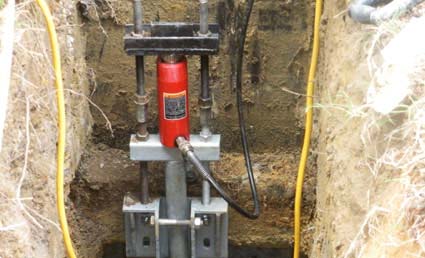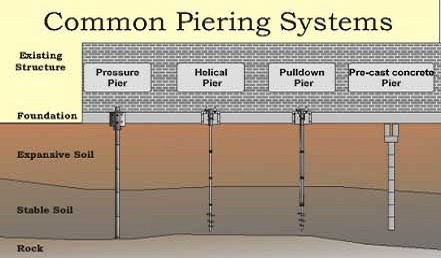Foundation Repair
Best Foundation Repair Contractor in Arizona
You can hire a professional foundation inspection and repair contractor in Arizona if, you are facing any foundation-related problems in your residential or commercial building. After a certain age, every building starts depreciating and then its foundation needs urgent repair and maintenance. But some methods are very expensive and most people don’t find the right foundation repair contractor and they get disappointed.
Mesa is a city located in south-central Arizona because the weather and other climate hazards cause the bad condition of foundations the building and houses. If you are living in the city and want to get the foundation repaired in mesa, AZ then you can hire a professional contractor at an affordable price. It is important to get the foundation repair done on time because delay may cause major damage or loss.
You can get affordable foundation repair in Scottsdale, AZ with the best industrial quality results. Scottsdale city is located in the deserts of Arizona and that is why its natural weather is warm and dry. Though, it is famous for its luxurious spas and resorts.
Because of its extreme weather conditions, buildings are harmed and get depreciated at an early age. By hiring a professional contractor, you can get all the foundation issues fixed. Professional foundation repair contractors know how to fix internal cracks and gaps.
Phoenix is the capital of Arizona located in the southern US. It is also known as the valley of the Sun because of its hot and sunny weather around the year. Hot and dry weather makes it difficult for the foundations and buildings to maintain their internal strength and power. People living in the city face various foundation-related challenges.
But if you hire a genuine contractor, you will not only get the right suggestions but your problems will also be fixed. Getting periodic foundation repair in Phoenix, Arizona is the smart strategy to keep the good health of the foundation.
Signs of Foundation Damage
Homeowners often wonder how to identify the different signs of foundation problems. It’s definitely a good question to ask. Here’s why – the longer you wait to treat visible signs of damage, the more severe the damage can become. Left untreated, minor cracks and leaks can turn into serious structural issues that compromise the value and overall health of your home.
Your home’s structural integrity depends on the strength of your foundation. It supports everything else – walls, windows, floors, doorways, roof – so when your foundation is damaged, it can cause serious problems throughout your home.
Like most things in life, your foundation is subject to environmental stress. Expanding and contracting soil, excessive moisture and inadequate drainage are some of the most common threats to your home’s foundation. Over time, environmental stress can cause the foundation to shift, crack or settle unevenly. And homeowners can often miss the early warning signs of foundation damage.
Foundation problems can create several issues throughout the home regardless of the foundation type. This includes slab on grade foundations, basements and crawl space homes like pier and beam foundations, or block and base builds.
Fortunately, most of these problems are hardly invisible, and signs of foundation problems need to be recognized and dealt with as early as possible to correct (and sometimes even prevent) major problems quickly.
Detecting Warning Signs Early
- Uneven or Sloping Floors
- Cracks In Exterior Or Interior Cinder Block
- Displaced Or Cracked Moldings and Kick Boards
- Wall Rotation/Twisting
- Cracks in Drywall or Bowing of Walls
- Cracks in Floor, Floor Tiles, Or Slab
- Doors and Windows Won’t Open and Close Properly
- Separation of Doors, Windows, & Garage Doors
- Spaces Between Wall & Ceiling Or Floor
- Walls Separating From House
What is Slab Heave?
Slab heave is uneven movement of a house footing and slab, and should never be misinterpreted as settlement. Many of the side effects of slab heave are the same. Slab heave causes damage to internal walls and ceilings. It can cause cracks in floor tiles. “Doming slab heave” is when the slab is higher in the middle than around the edge. “Dishing slab heave” is when the edges are higher than the middle of the slab.
Slab Heave Is:
- Uneven movement: Different parts of the house moving up and down; caused by
- Uneven changes in ground moisture: The amount of water in the soil; resulting in
- Swelling of Reactive clays: Clay soils swell (or increase in volume) when they become wet (or absorb moisture) and shrink when they dry out.

SLAB HEAVE HAS MANY OF THE SAME INDICATIONS THAT FOUNDATION SETTLEMENT HAS, BUT THE KEY, OR THE CURE OFR THIS IS MOISTURE CONTROL

What Causes Slab Heave?
Slab heave is caused by clay soils expanding when they absorb moisture. The source of moisture can be rainwater, broken sewer pipes, ground water, poor surface drainage and garden irrigation.
The amount of water in the ground is often uneven and so the movement in the house is uneven.
Slab heave can also be caused by the ground drying out. Causes of the ground drying out include tree roots, long dry seasons, terminating irrigation and uneven shading of the ground.
Slab Heave Affects Houses
Think about the day or week or month that your house was built.
Right up to the minute your concrete slab was poured, the ground moisture conditions in your allotment were pretty much consistent.
Now consider what happens when a concrete house slab is poured on your allotment. The slab covers some of the ground and stops it from getting wetter or drier. Around the edge of the slab the ground still gets wet and dry.
This variation in soil moisture under a house is what causes slab heave. If you could somehow keep all the ground wet or all the ground dry you could minimize the effects of slab heave.
Structural Lifting
The biggest problem with foundation repair is detecting the problem. Property owners that don’t fix their sinking foundations can expect to begin seeing signs of structural damage, such as wall cracks, and uneven floors, as well as wall separation. These are all scary things to see in a home or business, but most people just use plaster on the cracks and holes, then forget about it. They don’t realize that these cracks are an indicator of something going seriously wrong.

Generally Speaking, Arizona homes are built on slab foundations, and require that the footer be stabilized with either Helical Piers, or Pressure Piles. Once these have been installed, the internal slab can be lifted with either Mud Jacking, or Poly Foam Injection. The Key to all of it, is to stabilize the structure first.



Stabilization
Piling or piering is the technique of driving steel pipe pilings to remedy failing building foundations and to correct foundation settlement.
Push piers consist of sections of galvanized or epoxy-coated steel pipe that are driven into the soil with a hydraulic ram.
Helical piers use screw piles with steel shafts. The lead section, with one or more helixes attached, provides the needed bearing capacity. The piers are screwed into the ground with a hydraulic torque motor.
With either system, one or more steel piers are driven to rock or a suitable soil bearing layer and are connected to the foundation through a metal head assembly. Once a suitable bearing stratum is reached, each pile is tested to a force greater then required to support the structure.
Hydraulic jacks attach to the embedded steel piers and are used to raise the foundation back to its original elevation. Once the structure is restored to the desired elevation the piles are affixed (bolted or welded) to wall brackets, locking the new elevation of the structure.



Leaders in Residential Foundation Repair
Residential buildings face more foundation repair problems like; cracks, shifts, settle, and heave. These issues are quite serious and need immediate attention for repair. Searching the quality residential foundation repair contractors from the big market is a bit difficult task to do. Because hiring an ingenuine service contractor will waste your time and money yet, you will need to rework hiring a contractor.
Therefore, always stress the process of hiring a potential residential foundation repair professional.
Professional contractors have years of experience in handling different types of foundation repair problems. They are well-qualified and skilled to understand complex issues and working out the best-suited solutions. Some contractors are listed on top as the leaders in residential and commercial foundation repair services.
So, hiring the best out of all is an add-on advantage for you. Once you share all your needs with the contractor, half of your problems are already solved. By sharing your tension and problems related to foundation repair, your burden is shared by the services provider and you can do all your routine work.
Spend quality time with your family and friends and let your contractor fix the problems. With the advanced tools and techniques, it takes a couple of hours to complete the job with quality results. Mud jacking and Polyurethane foam foundation repair are effective solutions though, you can opt for other foundation repair solutions as well.
